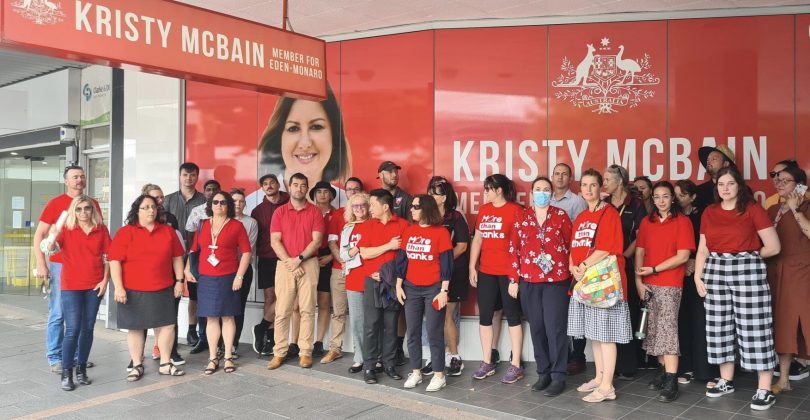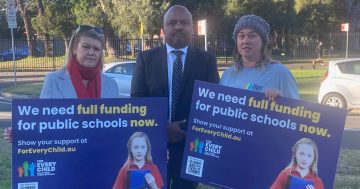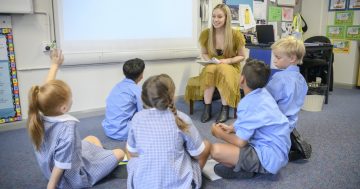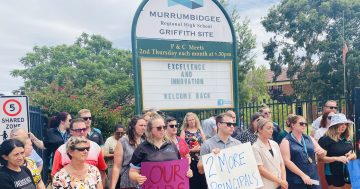
Queanbeyan High School teachers strike this morning. Photo: Supplied.
Queanbeyan High School teachers went on strike this morning (21 March), protesting the NSW Department of Education’s decision to return the school to full-time on-campus learning despite the school’s belief that they still do not have enough teachers.
Monday evening last week (14 March), students and parents were told that years 7 to 10 would move to flexible learning, meaning they would attend school three days a week and learn from home on the other two days. The Department of Education told the school to return to full-time in-person learning the next day.
A Queanbeyan representative for the NSW Teachers Federation, Mitch Andrews, said that the decision was “a slap in the face” to the school’s teachers.
“When teachers were told that we were going back to normal delivery; that is, all students at school, it was very deflating,” Mr Andrews said.
“We put our plan in place that meant that when students were at school, they were in front of their teachers with quality lessons occurring and when the students were at home, they had access to online learning resources.
“To be told that we can’t do what’s best for the students is demoralising and degrading. The staff are broken at the moment and are working really hard so that the kids are learning, but we physically can’t teach all of them.”
While other schools affected by the pandemic have been able to make decisions for themselves, Queanbeyan High School is different because they weren’t technically considered ‘COVID-affected’. They had multiple teachers on leave looking after their affected children, but no cases.
This morning, the strike ended with teachers returning to school “doing the best that they can” to educate their students.
NSW Teachers Federation President Angelo Gavrielatos said that recent figures provided to Parliament which spoke to a “previously unheard of” scale of combined classes and classes with minimal supervision was alarming.
“The government needs to pack away the spin and tell the truth – schools across NSW are in crisis. It is a stark reminder of why teacher shortages must be addressed as a matter of urgency,” Mr Gavrielatos said.
“We’ve had government report after government report. We’ve had inquiry after inquiry. Three days ago, there was another government report that said that unless we lift salaries and address workloads, we will not be able to attract the teachers we need.
“The government is trying to cover-up the teacher shortage crisis because it is refusing to act on its root causes: unsustainable workloads and uncompetitive salaries.
“Senior Department of Education officials are now attempting to censor principals from advising parents on the severity and the impact of the teacher shortage on students’ learning. They seem more concerned about the embarrassment it would cause the Minister, which is unprecedented,” he said.
Speaking on the current staffing shortages at Queanbeyan and Karabar High Schools, Member for Monaro Nichole Overall recognised the “understandable concern” within the local community.
“The leadership teams of the schools have worked hard to manage the inevitable pressures of COVID-19. I have been given assurances that the Department of Education is providing all support available to keep schools in our area operational,” Ms Overall said.
“We recognise the all-round impacts. Ensuring the ongoing well-being and educational needs of our young people is critical. We are all committed to finding the best path forward to deal with these ongoing challenging times.”
NSW Leader of the Opposition Chris Minns said that the “government is abandoning schools”.
“NSW is in a teacher shortage crisis – 1-in-3 teachers are looking to quit in the next five years. A majority of teachers are working over 60 hours a week and schools are being forced to go part-time,” Mr Minns said.
“Instead of tackling this issue head-on, the NSW Government is pretending it isn’t happening. Doing nothing and sticking your head in the sand is a recipe for disaster for kids in NSW.”
Original Article published by Max O’Driscoll on Riotact.
















